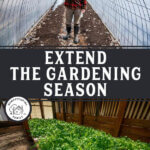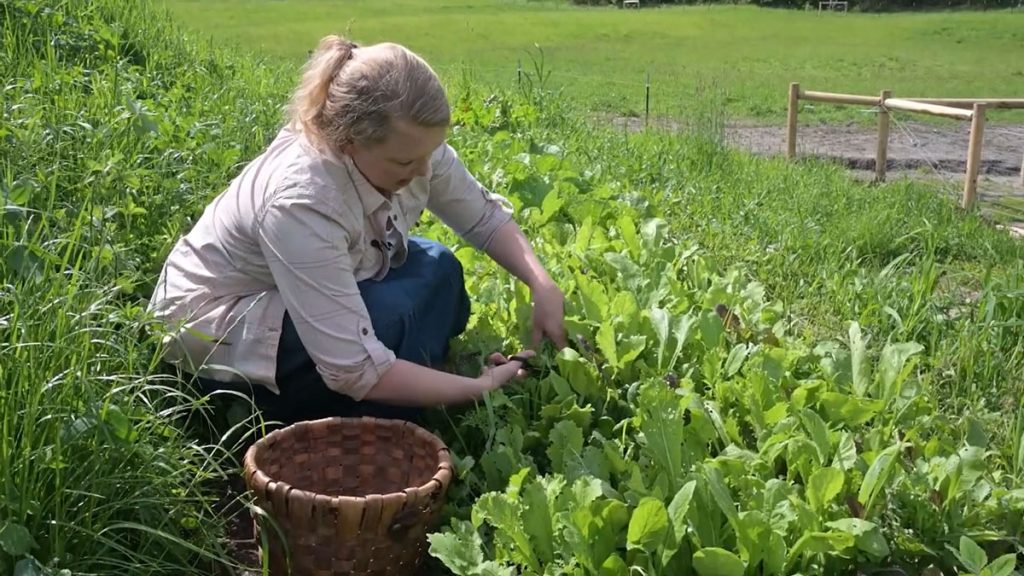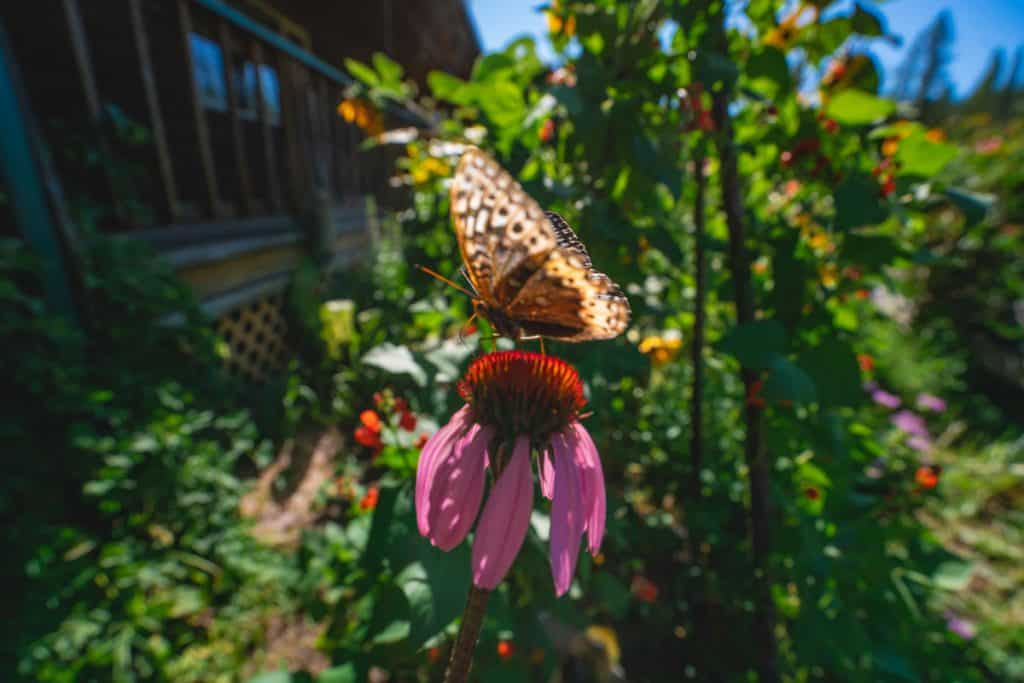
Living in the far north of Idaho, we know what it means to live in a climate with a short growing season. We don’t let our weather limit us. Learn to extend the growing season with these methods.

Many people in our area only garden for 3-4 months of the year due to the weather. We’ve learned to extend that growing season to 6-8 months (even year-round with certain crops)! We endeavor to produce food as many months of the year as possible and harvest continually throughout our extended growing season.
Adding greenhouses, DIY hoop houses, high tunnels, floating row covers, cold frames, raised beds, or other agriculture infrastructure to your space can extend your growing season. Still, they often take time, planning, and money, which many homesteaders do not have right away.
We want to share our way of optimizing our garden without spending much time and money, allowing us to have a long growing season with a continual harvest that you can apply to your particular climate or growing zone.

A New Approach
Abandon the idea that you plant your garden at one time and then expect one harvest at the end of the season during a short window.
This approach limits the amount of fresh eating available to you and your family. You end up eating some fresh foods and preserving the rest in a short amount of time.
This results in hours of canning, fermenting, dehydrating, or other methods of preserving, all in a few short weeks, which causes stress and exhaustion.
Conversely, we want to show you how to stagger the harvests so that your food will be ready to preserve at different times, spreading out your time and efforts so that you have sustainable access to growing your food without the stress and pressure.
Homesteading Hack: Don’t start harvesting your garden without a plan. Prepare for preserving foods in advance and plan for busy preservation days.
We plan and design our garden so that we can eat more fresh fruits and vegetables while at the same time limiting the amount of food we need to preserve.
With a longer growing season comes a shorter off-season, decreasing the amount of preserved foods we need to use during the winter months. This way, we can eat the foods we have grown all year long.

The Benefits of Eating Fresh
When you eat the fruits and vegetables that you have grown fresh, you get the most nutritional value possible from the food.
In most food preservation, degradation occurs, meaning fresh foods lose nutrients when they undergo freezing, canning, or other preservation methods. The two preservation methods we’ve grown to love are freeze-drying and fermenting because these maintain or increase the nutrients. However, we also realize not everyone can afford a home freeze-dryer (you can read my one-year review of our freeze dryer here) and fermenting is not everyones cup of tea.
Homesteading Hack: If you’d like to give fermenting a try, check out our fermenting 101 post here. We recommend trying these fermented ginger carrots first, they’re our children’s favorite ferment.
Working toward having a continual harvest throughout the warm days of the growing season means that you can continually eat fresh foods gaining the most value from your garden.

Extend Growing Season – Homestead Strategies
We use a few simple strategies to optimize our growing season. We extend our planting season, stagger our planting, and store our fresh produce properly for long-term storage.
With all these strategies in mind, do your research and know your particular climate, average first and last frost dates, and information about your grow zone. Use a garden vegetable planner to know when to plant and when to expect a harvest.
Choose the best vegetable seeds for your garden and check the seed catalog to know the time from seed germination to harvest. This will help you know when to start your seeds indoors or whether you will direct sow them outside.

Extending the Planting Season
Start planting as soon as possible in early spring. Some plants can be direct sown prior to the last frost as soon as the soil is workable (as long as the ground isn’t too soggy). You can even learn strategies to warm the soil to start planting earlier.
Start by planting cool-season crops like mustards, cold-hardy greens, radishes and brassicas. Homesteading Hack: Be sure you choose varieties specifically for the colder season when choosing your seeds.
You can get a head start on the planting season by starting your seeds indoors and researching tips for early spring gardening.
Continue to plant these cool-weather-loving crops into the fall. Research which plants you can plant in late summer for a fall harvest. Root vegetables like carrots and beets grow well late in the growing season.
Also, you can plant greens like bok choy, kale, Swiss chard, and spinach late. And broccoli, cauliflower, cabbage, fava beans and peas can survive the cooler temperatures of fall when the sunny days of summer have passed.
You can push out the edges of your area’s growing season by carefully planning when and what to plant.

Stagger the Plantings
Use succession planting to stagger your harvest. By doing more than one planting you’ll stagger when those crops come to maturity so you can continually eat the fresh produce without the need for preserving it before it goes bad.
We love to do this with our “cut and come again lettuce” method.
Another option is to plant your seeds in dense, tight rows. Instead of thinning when the seedlings pop up, allow the vegetable to grow. Harvest the young version of the vegetable to thin your crop, spaced apart to allow the remaining vegetables to grow to full size.
Eventually, let the plant reach full size before the final harvest. This way, you can get multiple harvests from the same plant, and we can grow more food in less space all season long.
With succession planting, you allow yourself the ability to harvest some vegetables for fresh eating while others are still growing for long-term storage.

Plant a Storage Crop
In addition to staggering the planting, you can plant a separate crop you plan to use for storing.
The purpose of this crop is to allow you to eat the first crop you planted fresh because you have the second (or third) crop for long-term storage to take you through winter. We often do this for crops like carrots, cabbage and potatoes.

Keep Plants Alive and Available to Harvest
Some plants withstand very low temperatures, and you can harvest them in winter. In milder climates, some plants can be harvested all through the winter.
Swiss chard is a great example that does well in colder climates. To protect your crops, cover the mature chard in clear plastic to shield it from the snow and to provide protection from wind or frost. If the weight of the snow is trampling the plants, you may need to utilize some PVC pipe or bent-over cattle panels for support. Chicory, kale and tat soi are all good crops for cold winters.
The one misconception is that the plants continue to grow throughout the winter months. That’s not true, the plants are simply in dormancy and you can continue to harvest the mature leaves (or roots) of the plant. That’s why it’s important to understand timing. You want your plants at full maturity before the first frost comes in the fall.
Then, leaving them in the ground is, in essence, a way to preserve and store food.
Carrots, parsnips and other root vegetables can taste sweeter when left as a storage crop as well. Growing hardy crops and plants that can survive a frost will help extend the growing season. Do your research, as many plants will not withstand a frost or will not germinate in a low soil temperature.

Grow Perennials
If you want a sustainable garden, grow perennials like fruit bushes, fruit trees, and nuts, or even a cottage garden full of perennial herbs.
Fruit trees and fruit bushes are vital to extending the growing season. As you plan your homestead, plan for fruits that you can harvest early, like cherries and strawberries as well as fruits that you can harvest late, like apples and pears.
When designing a cottage garden, be sure to plant both culinary and medicinal herbs and foods like sorrel, lovage and good King Henry that you can eat as leafy vegetables. These are some of the earliest edible plants to come up in the spring.
Perennials are less work as they come up independently and wait for you to harvest them with little work and effort. And they are also very beneficial to your overall ecology or ecosystem.
Try planting something you haven’t tried before. With a bright, lemony flavor, this sorrel sauce is a burst of delicious flavor.

With all these strategies, we hope we’ve encouraged you to look at the growing season as more than just a single planting and a single harvest. When utilizing these growing strategies, you can grow a lot more food for your family while also preserving a good deal for year-long use.
More Helpful Gardening Strategies
- Spring Garden Planning Ideas, Tips & Tricks
- Garden Planning for Serious Food Production
- How to Use a Vegetable Garden Planner
- Seed Starting Problems (& How to Fix Them)
- When to Harvest Potatoes
- Making Raised Garden Bed Rows & Super-Charging Your Soil
- How to Grow Greens Year Round
- Crops That Will NOT Survive a Frost (Non Hardy-Vegetables)


















